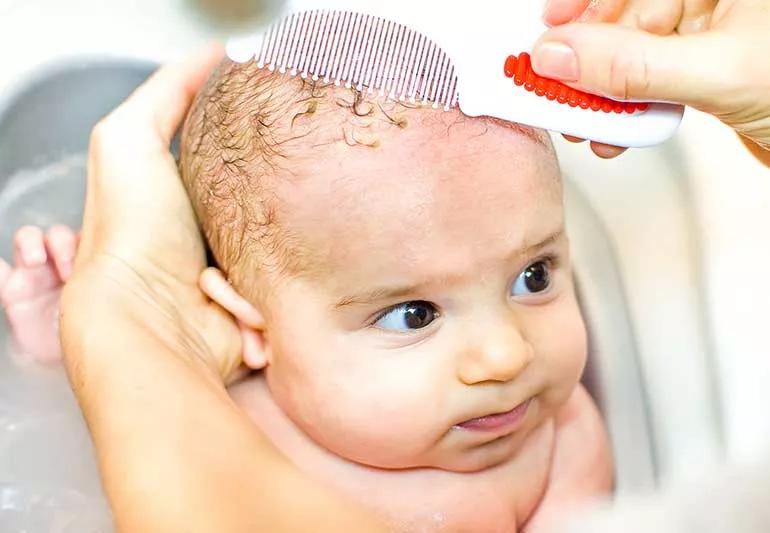Advertisement
Moisturizer, a daily bath and some gentle nudging can help

It’s hard for parents not to stare at their newborn. You gaze down at them while they eat, sneak peeks while they sleep and examine every inch of their little body. So, when your bundle of joy develops cradle cap — you notice. What are those thick yellow or white scaly patches on their scalp?
Advertisement
Cleveland Clinic is a non-profit academic medical center. Advertising on our site helps support our mission. We do not endorse non-Cleveland Clinic products or services. Policy
“Cradle cap is a buildup of excess waxy skin on the scalp,” says pediatrician Marni Turell, MD. “It typically shows up when babies are between 2 and 4 weeks old, but it can continue through the first year of life.”
Cradle cap doesn’t bother babies and rarely requires medical attention. It’s a form of seborrheic dermatitis — a skin condition that can cause stubborn dandruff in adults.
“It doesn’t hurt, itch or cause pain,” Dr. Turell says. “It typically bothers the parents more than the child.”
But if your baby is one of the 70% of infants who develops cradle cap — and it does bother you — there are things you can do to help remedy the situation.
Cradle cap doesn’t indicate a health issue, isn’t contagious and tends to clear up on its own. But some babies can have cradle cap for months or the entire first year of life. When that happens, it’s understandable if you want to help your newborn put their best scalp forward.
“You don’t have to treat it because it doesn’t affect your baby’s health,” Dr. Turell clarifies. “But you can take steps at home that may reduce your newborn’s cradle cap.”
To get the maximum effect, she suggests making all four of the following tips a part of your daily routine:
The scaly patches on your baby’s head are clusters of dead skin cells. Moisturizing that skin is the best way to reduce the buildup and loosen the patches. Dr. Turell recommends applying petroleum-based moisturizer, baby oil or mineral oil — about the size of a nickel — to your child’s head about 30 minutes before bath time.
“These moisturizers help loosen cradle cap scales,” she explains. “But they can also be messy and leave your baby’s hair feeling greasy. Doing it right before the bath, when you can wash out the oil, makes it easier to keep up with the routine.”
Advertisement
But don’t dump on the moisturizer and call it a day. Gently massage it into their scalp with your fingers. The motion pushes the oil under and around the scales and may help break up big patches.
Cradle cap doesn’t happen because of poor hygiene. But washing your baby’s scalp more often can help improve the condition.
“After the umbilical cord is off and the circumcision heals, I often recommend bathing your newborn as part of a healthy nighttime routine,” Dr. Turell says. “While you don’t have to wash your baby’s hair daily, it can be helpful when trying to soften and manage cradle cap.”
When washing your infant’s scalp:
Shampoos claiming to reduce cradle cap are available. But check the ingredients to make sure they’re mild or ask your healthcare provider for an over-the-counter shampoo recommendation. If your baby has dry skin or eczema, daily bathing may not be ideal. Follow your provider’s advice on how often to bathe your infant.
The moisturizer and shampoo should soften and loosen some of your baby’s cradle cap. To help it along, gently lift the thickened skin away from their scalp using a soft baby brush, comb or toothbrush. Avoid using your fingernails, which are more likely to scratch the delicate skin on their scalp.
“Don’t scrape so much that you cause irritation, redness or bleeding,” Dr. Turell cautions. “The goal is to gently open the patches and softly scrape out whatever you can without being too aggressive.”
If the scales are persistent and won’t easily loosen, she says to leave them alone and repeat the process the next day. Over time, they should become easier to remove.
One of the best things you can do for cradle cap, says Dr. Turell, is to leave it alone — especially when it’s dry. Forcefully pulling or picking off scales that aren’t already loose may irritate or injure the healthy skin beneath it and cause:
“The thickened scales won’t come off easily unless softened first,” she adds. “Newborn skin is delicate, and it won’t take much to damage it.”
Most cases of cradle cap don’t require medical care and will clear up without intervention. But it’s always a good idea to mention your concerns at your infant’s well visit and ask your provider for suggestions.
“At least half of the babies we see have cradle cap at one point or another,” Dr. Turell notes. “And there are varying degrees of severity. Some cradle cap is thicker and lasts a long time. Other times, it’s barely noticeable and clears up within a week or two.”
But the following instances are examples of when you should call your pediatrician and get your baby’s cradle cap checked:
Advertisement
These symptoms could mean that your baby may need stronger treatment or has a similar condition, such as atopic dermatitis or scabies. Your pediatrician may prescribe a topical medicine (one that goes on their skin) or shampoo. But even if those steps aren’t necessary, your pediatrician can answer all of your questions and ease your concerns. Either way, you can rest assured that your baby will likely have a smooth scalp soon.
Advertisement
Learn more about our editorial process.
Advertisement

Burping, gas drops and extra tummy time are just a few ways to help your wee one rip one

Yes, it’s safe for babies starting at about 9 months old and can help clear nasal mucus

Wait until they’re at least 6 months old before your little one takes their first dunk

The birthing process can take longer than you might expect, and plans can always change

From newborn through teen years, your child’s sleep needs will change

An occasional drink is OK, and you can safely nurse your baby after the alcohol has left your breast milk

A sunken soft spot may be a sign of dehydration, while a bulging soft spot may be a sign of head trauma

Knowing how much time your baby should typically go between naps can help keep them on a more regular schedule

Focus on your body’s metabolic set point by eating healthy foods, making exercise a part of your routine and reducing stress

PFAS chemicals may make life easier — but they aren’t always so easy on the human body

While there’s little risk in trying this hair care treatment, there isn’t much science to back up the claims